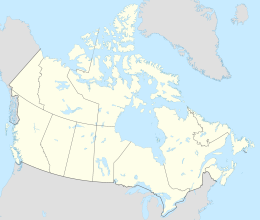Uninhabited island in Nunavut, Canada
Brevoort Island is a small, uninhabited island located in the Davis Strait off the eastern coast of Baffin Island in the Qikiqtaaluk Region of northern Canada 's territory of Nunavut . The island is a member of the Arctic Archipelago and lies north of Cape Murchison , opposite the Cumberland Peninsula .
Geography and climate
Brevoort Island, with an area of 271 km2 (105 sq mi), is 46 km (29 mi) in length, and 5–7 km (3.1–4.3 mi) in width. It has a hilly interior, mostly composed of granite.[ 2]
Brevoort Island has a tundra climate (Köppen : ETf ; Trewartha : Ftkc )
Climate data for Brevoort IslandWMO ID : 71097; Climate ID: 2400565; coordinates 63°20′23″N 64°08′45″W / 63.33972°N 64.14583°W / 63.33972; -64.14583 (Brevoort Island )
Month
Jan
Feb
Mar
Apr
May
Jun
Jul
Aug
Sep
Oct
Nov
Dec
Year
Record high humidex
−1.1
2.2
−0.6
5.0
8.1
18.0
20.7
20.0
17.1
6.7
0.2
−0.3
20.7
Record high °C (°F)
0.1
2.2
0.2
6.1
13.7
17.2
22.0
21.6
16.7
7.8
1.3
0.0
22.0
Mean daily maximum °C (°F)
−18.8
−20.0
−16.2
−9.7
−2.8
3.1
8.3
7.8
2.3
−2.5
−7.1
−12.8
−5.7
Daily mean °C (°F)
−21.2
−22.5
−19.0
−12.2
−4.9
1.0
5.6
5.4
0.6
−4.1
−9.2
−15.1
−8.0
Mean daily minimum °C (°F)
−23.6
−25.0
−21.7
−14.8
−6.9
−1.2
2.8
2.8
−1.1
−5.8
−11.2
−17.4
−10.3
Record low °C (°F)
−37.3
−40.6
−38.3
−31.7
−20.0
−11.1
−6.1
−6.1
−10.1
−20.6
−27.8
−34.8
−40.6
Record low wind chill
−57.5
−63.1
−54.2
−45.3
−31.7
−20.1
−13.8
−13.2
−17.3
−34.0
−43.9
−52.6
−63.1
Source: Environment and Climate Change Canada Canadian Climate Normals 1991–2020[ 3]
Military use
The island is the home of BAF-3, a North Warning System Long Range Radar site. Before the transition to the NWS it functioned as a rearward communications (relay) station for the Distant Early Warning Line , designated as RES-X-1 [ 4]
References
External links

